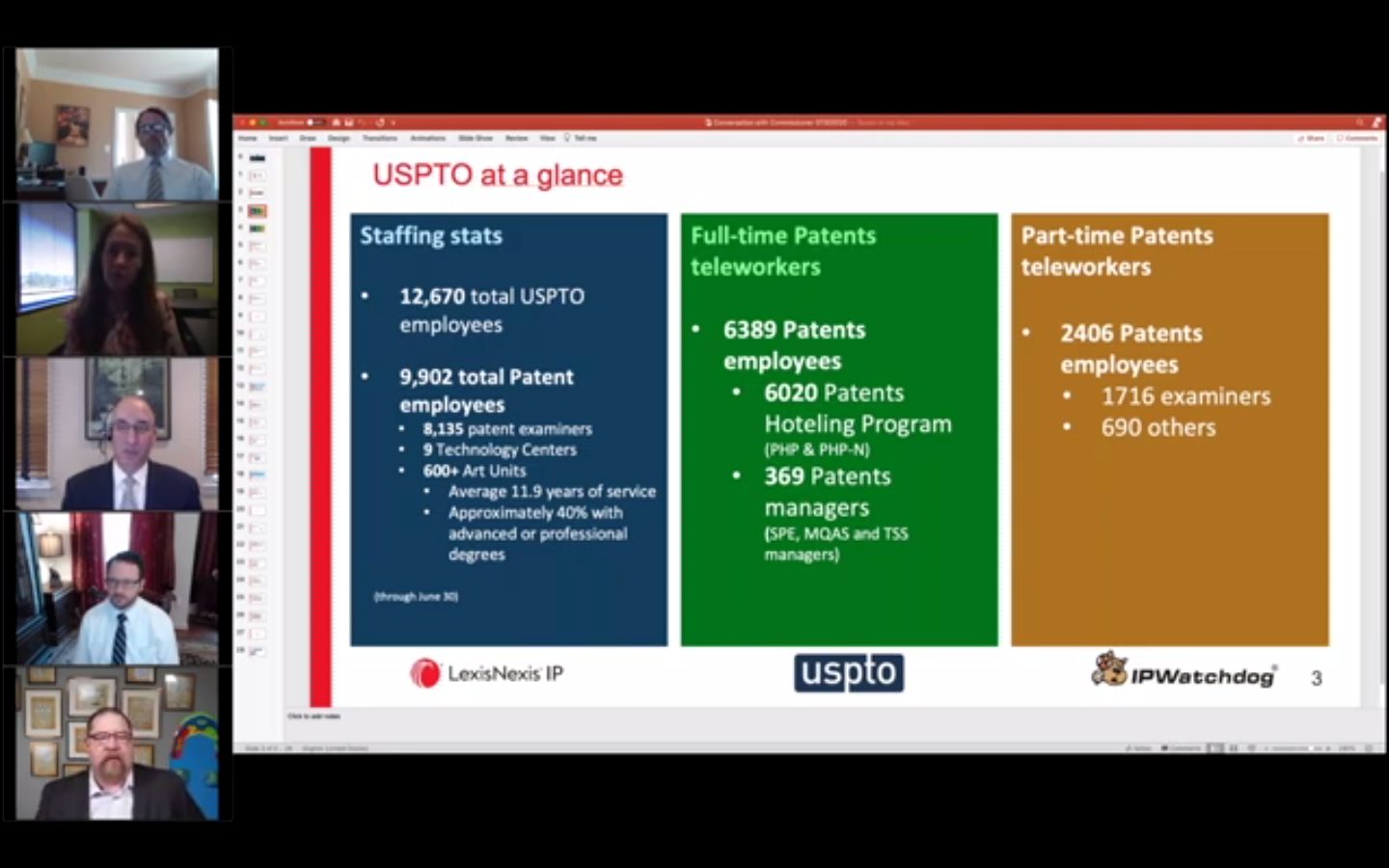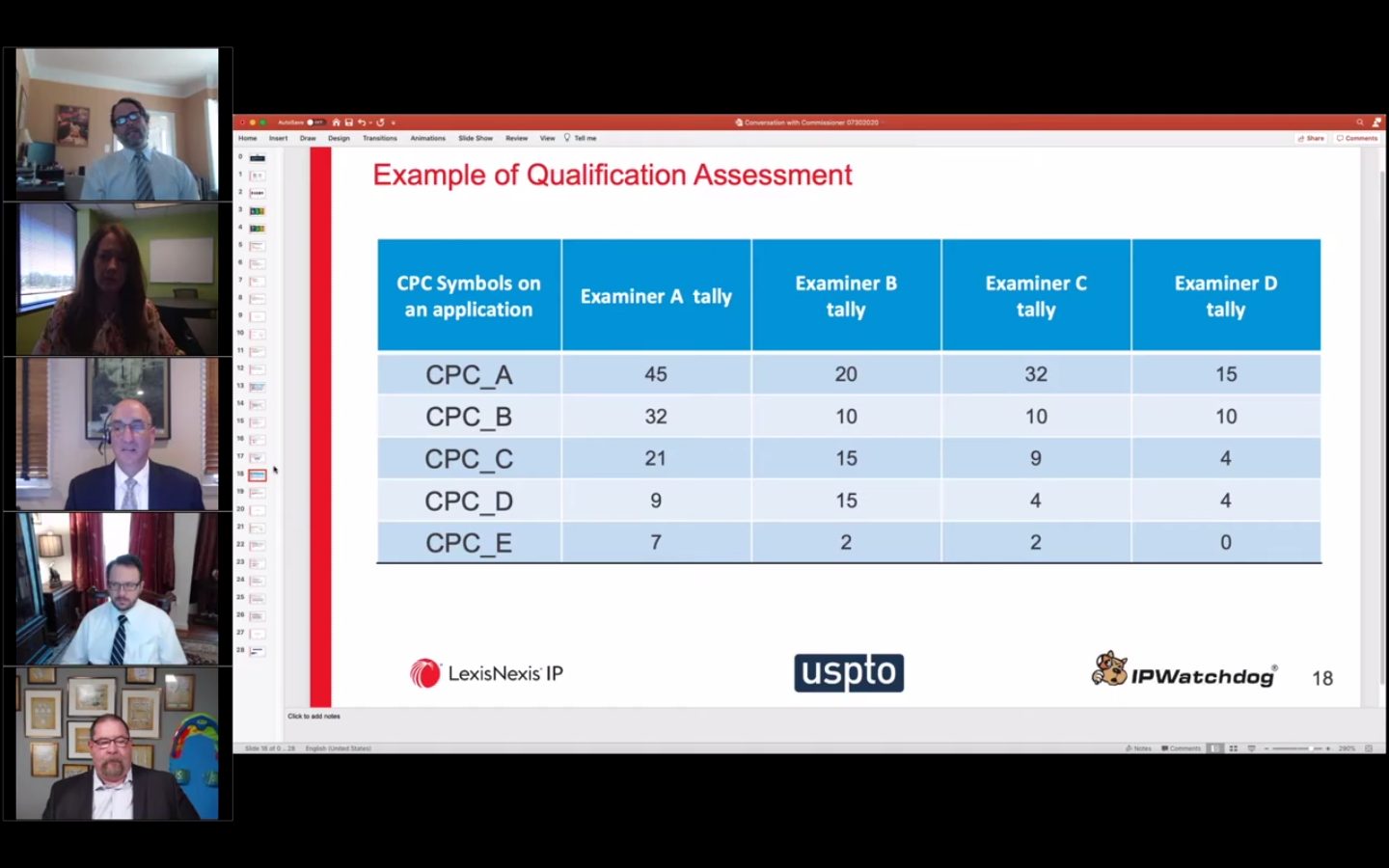“The new system will allow applications to be coded according to multiple disciplines, rather than just one, and will allow more flexibility to find examiners with the specific expertise in the technologies.”
 On Thursday, July 30, U.S. Patent and Trademark Office (USPTO) Commissioner for Patents Drew Hirshfeld and other USPTO staff updated attendees of IPWatchdog and LexisNexis’ webinar, “A Conversation with the Commissioner: A Look Inside Patent Processes at the USPTO,” on issues such as staffing, reopening plans, and upcoming new processes for routing patent applications.
On Thursday, July 30, U.S. Patent and Trademark Office (USPTO) Commissioner for Patents Drew Hirshfeld and other USPTO staff updated attendees of IPWatchdog and LexisNexis’ webinar, “A Conversation with the Commissioner: A Look Inside Patent Processes at the USPTO,” on issues such as staffing, reopening plans, and upcoming new processes for routing patent applications.
Hirshfeld explained that the Office is currently in phase one of reopening and at “maximum telework” capacity. In March, the Office went to mandatory telework, but recently began allowing some employees—up to a maximum of 100 at a time—back in the office. This is a “minuscule” number compared to normal Office capacity, said Hirshfeld. There is no date set for the Office reopening to the general public.
The USPTO’s telework program is famously used by a large majority of staff, which allowed the office to seamlessly transition during the pandemic. In fact, the Office is trending at a slightly higher productivity than projected for the year before the pandemic, said Hirshfeld. However, he warned that there’s likely to be a latent impact on productivity once the pandemic ends, as employees in general are not taking leave right now. “They’re working more hours than they normally would, so there’s likely to be a drop-off in productivity,” Hirshfeld said. “This is not unique to the USPTO.”
The number of filings is slightly up, at 1.4%. Before March, filings were trending at a 4% increase over last year, so there has been a decrease, and compared to last year, there is a decrease of about 2.5%. “We’re actively watching that,” Hirshfeld said. Though he said the Office is “in a good place,” he also cautioned that patents are often a lagging indicator of changes to the economy, so there could be larger impacts down the road. Fee revenues are also slightly down, about 1.5% from what was projected for the year.
IPWatchdog Founder and CEO, Gene Quinn, said the relatively mild decrease of 2.5% considering the dire circumstances did not surprise him, as, anecdotally, large companies tend to hunker down while small companies and individuals become more active. Hirshfeld did not have statistics on such trends but said he would get them. “If that’s really what’s going on that’s good news for the future of America,” Quinn said. “Creative people take the opportunity to create, which could be a real silver lining message.”
Big Changes
Hirshfeld queued up Jay Kramer, Group Director Patent Operations, Tech Center 2400, to explain some “foundational changes” coming in October 2020. In 2010, the Office signed an agreement with the European Patent Office to adopt a Cooperative Patent Classification (CPC) system, in a step toward international harmonization. About 50 other patent offices worldwide are using CPC.
 The new system will allow applications to be coded according to multiple disciplines, rather than just one, and will allow more flexibility to find examiners with the specific expertise in the technologies. These multiple symbols will create a “classification picture” that can be matched with examiners’ skills via their “examiner portfolio.” The changes are expected to allow for better quality examination of applications.
The new system will allow applications to be coded according to multiple disciplines, rather than just one, and will allow more flexibility to find examiners with the specific expertise in the technologies. These multiple symbols will create a “classification picture” that can be matched with examiners’ skills via their “examiner portfolio.” The changes are expected to allow for better quality examination of applications.
Asked by Megan McLoughlin, Director of Product Management for LexisNexis IP, what will happen to the traditional “art units” at the USPTO, Kramer explained that, while they will certainly be fundamentally changed and arguably less needed, their primary focus, which is training and guidance from Supervisory Patent Examiners, will remain intact.
To hear more on the upcoming changes at the USPTO, including how artificial intelligence technologies will be used for classification, listen to the full webinar here.

![[IPWatchdog Logo]](https://ipwatchdog.com/wp-content/themes/IPWatchdog%20-%202023/assets/images/temp/logo-small@2x.png)

![[Advertisement]](https://ipwatchdog.com/wp-content/uploads/2024/04/Patent-Litigation-Masters-2024-sidebar-700x500-1.jpg)

![[Advertisement]](https://ipwatchdog.com/wp-content/uploads/2021/12/WEBINAR-336-x-280-px.png)
![[Advertisement]](https://ipwatchdog.com/wp-content/uploads/2021/12/2021-Patent-Practice-on-Demand-recorded-Feb-2021-336-x-280.jpg)
![[Advertisement]](https://ipwatchdog.com/wp-content/uploads/2021/12/Ad-4-The-Invent-Patent-System™.png)






Join the Discussion
2 comments so far.
Kim Jordahl
August 11, 2020 10:33 amThank you for this webinar! I am grateful for the info, even though I find it somewhat depressing. I don’t think this comes as good news to those that routinely get “stuck” with Examiner’s with allowance rates of less than 10%. Or, those that routinely deal with Examiner’s that base rejections on their own opinions or “knowledge of the art” without citation to the art itself. Personally, I would would rather deal with an Examiner with lesser experience in an art area, that actually has to rely on a good search and thorough review of the results to support a rejection than a more experienced Examiner that falls into the “I know this art area better than anyone” category any day.
David Stein
August 3, 2020 12:15 pmPretty interesting. Adapting to the CPC harmonization effort will provide a lot of convenience.
Remapping application routing for “multiple disciplines” raises some interesting prospects. The devil is in the details as to whether it will make matters easier or more complicated, both inside and outside the PTO.